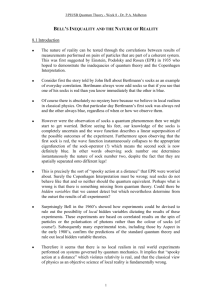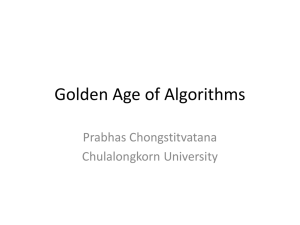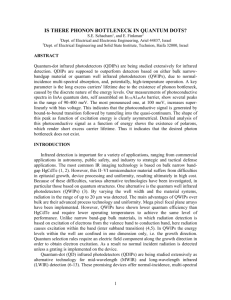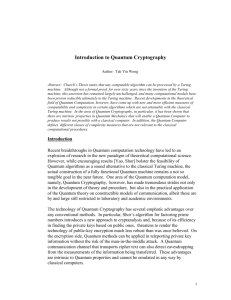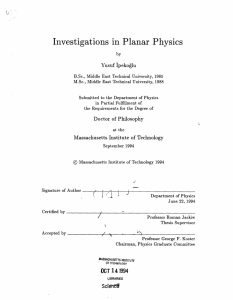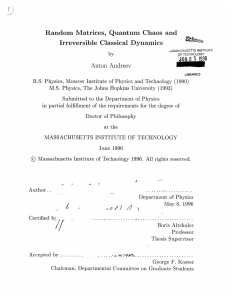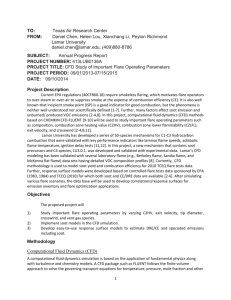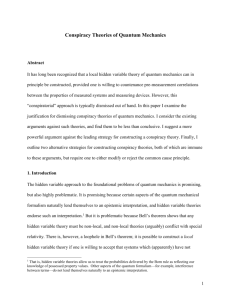this MS-word document
advertisement
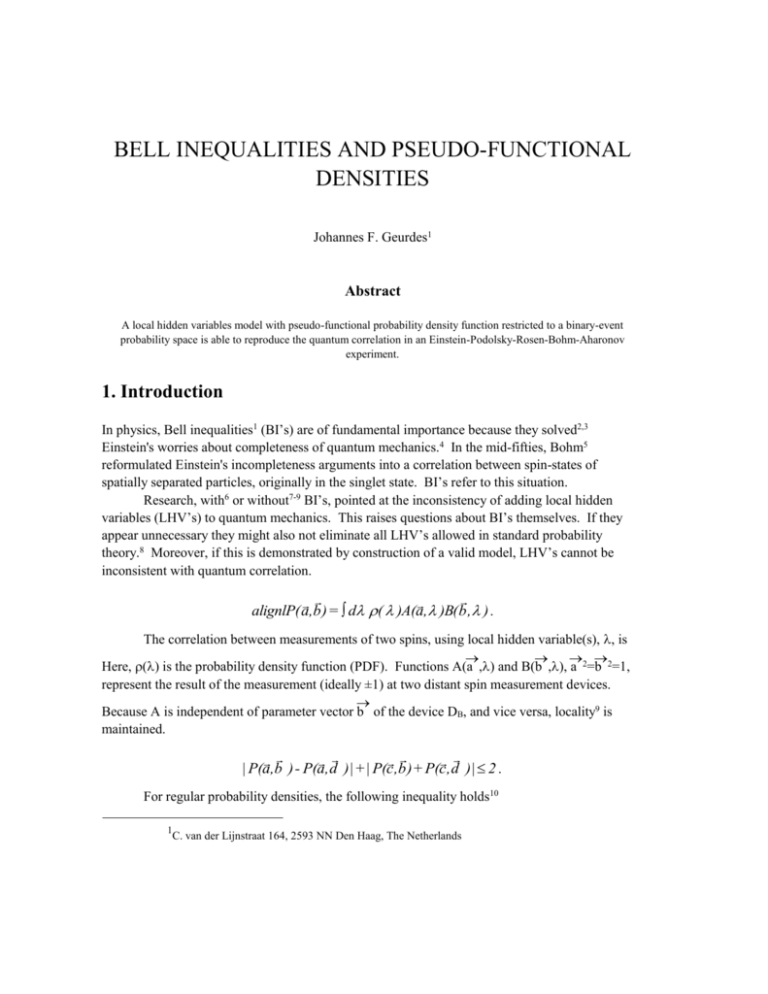
BELL INEQUALITIES AND PSEUDO-FUNCTIONAL
DENSITIES
Johannes F. Geurdes1
Abstract
A local hidden variables model with pseudo-functional probability density function restricted to a binary-event
probability space is able to reproduce the quantum correlation in an Einstein-Podolsky-Rosen-Bohm-Aharonov
experiment.
1. Introduction
In physics, Bell inequalities1 (BI’s) are of fundamental importance because they solved2,3
Einstein's worries about completeness of quantum mechanics.4 In the mid-fifties, Bohm5
reformulated Einstein's incompleteness arguments into a correlation between spin-states of
spatially separated particles, originally in the singlet state. BI’s refer to this situation.
Research, with6 or without7-9 BI’s, pointed at the inconsistency of adding local hidden
variables (LHV’s) to quantum mechanics. This raises questions about BI’s themselves. If they
appear unnecessary they might also not eliminate all LHV’s allowed in standard probability
theory.8 Moreover, if this is demonstrated by construction of a valid model, LHV’s cannot be
inconsistent with quantum correlation.
alignlP( a,b ) = d ( )A(a, )B( b , ) .
The correlation between measurements of two spins, using local hidden variable(s), , is
Here, () is the probability density function (PDF). Functions A(a ,) and B(b ,), a 2=b 2=1,
represent the result of the measurement (ideally ±1) at two distant spin measurement devices.
Because A is independent of parameter vector b of the device DB, and vice versa, locality9 is
maintained.
| P(a,b ) - P(a, d ) | + | P(c ,b ) + P(c , d ) | 2 .
For regular probability densities, the following inequality holds10
1
C. van der Lijnstraat 164, 2593 NN Den Haag, The Netherlands
The quantum correlation, P(a ,b )=-(a b ), violates the inequality. Hence, a distinction between
hidden variable predictions and quantum mechanical predictions is possible.
In this letter we present a classical probabilistic singular LHV’s model which meets the
= ( ) 0, ,
< >= 1 ,
A = A(a, ) = + - 1, B = B( b , ) = 1,
| < A > |= 0,| < B > |= 0,
< A2 > = < B 2 > = 1,
< AB > = -(a b ),
following:
with <f>=df(). An extra condition is that the density is associated with a genuine probability
space.
Pf
(x)
x
={
1/x, x > 0
0,
x0
In the probability density, the pseudo-function
is used which represents the positive branch of the principal value function.10 Here, (x)=1,
when, x>0, (x)=1/2, when, x=0, while, (x)=0, when x<0.
Moreover, two integrals are crucial. Let us inspect [-,+], with =exp(3-3/4)1.5507.
+
-
We find that
d P f
( )
= _ p d overlambda = C = 3-3/4 ,
0
J. F. Geurdes
53
with _p Hadamard's finite part.13 The integral of the product of the pseudo-function and the sign
+
( )
d
d
sign(f - ) = _ p {
-
} = -1 ,
f
0
f
d P f
-
function, defined here as sign(x)=+1, x0, while sign(x)= -1, x<0, is
when f=exp((C-1)/2)0.7553, C=3-3/40.4387. Note that f<. The choice of parameters will
become clear later on.
Subsequently, the model is presented and Eq. (3) is verified. First, the integrations are
3
3
4
+
+
2
+1
d intfrom - d d
q=1 nq=1 =1 -
s
< > .
s=1 -1
understood as
Hence, the variables nq, and s, in the specified ranges, are postulated.
1 4
( ) 1
exp(- 2 /2) , = true,
Pf
4 =1
2
={
.
0, = false
Second, the singular probability density function is specified by
Here, (n1,n2,1,...,4,,1,2) is true when the following conditions apply. In the first place, nq
must only run through the complete set {1,2,3}, excluding all other sets. Secondly, must only
run through the complete interval [-,], excluding other intervals. Thirdly, the , must run trough
the complete real interval (-,) excluding other intervals, subsets of (-,). Fourthly, s must
only run through the complete set [-1,1], excluding all other intervals. If one of the associated sets
that defines the range of a particular hidden variable is unequal to the one indicated, i.e., to
{1,2,3}, [-,], (-,), or, [-1,1], and/or the variable lies outside the indicated set, then (n1,...,2)
is false. Note that it is not unusual that intervals determine a PDF.
In addition, let us specify a delta function for sets X and Y as (X,Y)=1, when X=Y,
while (X,Y)=0 when XY. Moreover, the universal event is given by ={1,2,3}3[-,]4(,)[-1,1]2, with {1,2,3}3={1,2,3}{1,2,3} {1,2,3}, etc, whereby is the Cartesian product,
and {} is the empty set.
From the previous specifications, we see a binary-event probability space associated to .
Accordingly10 this space is written as (Q,_,P[]), with _={,{}} and P[Q]=<(Q,)>, Q_.
Bell Inequalities and Pseudo-Functional Densities
54
Hence additivity, P(Q)+P(Qc)=1, with Qc=\Q, (QQc={}), is warranted in (Q,_,P[]), while the
other basic axioms (Ref.10, page 22) also hold for (Q,_,P[]). Hence, an elementary probability
space can be associated to the density , from which valid probability measures can be obtained.
Observe that BI’s do not forbid binary probability spaces, such as (Q,_,P[]), to be associated to
densities to be used in Eq. (1). Moreover, the discreteness of the spin space coincides with the
probability space.
A = sign( ) sign{ n1,n2 an2 sign(f - 1 )sign(f - 2 ) - 1 },
Fourth, in the model the functions A and B are given by
B = -sign( ) sign{ n1,n3 bn3 sign(f - 3 )sign(f - 4 ) - 2 } ,
and
with x,y=1 when x=y, while x,y=0 when xy, and A2=B2=1.
1
2
1
2
+
d exp(-
2
/2) sign( ) = 0,
-
+
d exp(
2
/2) {sign( ) }2 = 1 .
We first may observe that 0. Second, it follows that <>=1. Third, because
it follows that <A>=<B>=0, while <A2>=<B2>=1. Fourth, because a 2=b 2=1, the density
3
3
3
< AB > = - k,m k,n a m bn
k =1 m=1 n=1
+
_{
d P
-
f
( )
sign(f - ) }4 ,
entails that we also have
from which it follows that <AB>=-(a1b1+a2b2+a3b3)=-(a b ).
For completeness, the conflict with BI’s emerges from operations with absolute signs
leading to BI’s. In our case we have
J. F. Geurdes
55
+
1 =|
-
d P f
+
( )
( )
sign(f - ) | d | P f
|= 3-3/4 ,
-
which is contradictory. Hence, no straightforward path may lead here to BI’s.
This concludes the proof that a valid local hidden variables model is possible that remains
within the bounds of classical probability theory. Because of this, the model cannot beforehand be
dismissed as unphysical.
References
1.
J. S. Bell, Physics 1, 195 (1964).
2.
J. F. Clauser and A. Shimony, Rep. Prog. Phys. 41, 1881 (1978).
3.
A. Aspect, P. Grangier and G. Roger, Phys. Rev. Lett. 49, 91 (1982).
4.
A. Einstein, N. Rosen and B. Podolsky, Phys. Rev. 47, 777 (1935).
5.
D. Bohm and Y. Aharonov, Phys. Rev. 108, 1070 (1957).
6.
E.S. Fry, T. Walther and S. Li, Phys. Rev. A52, 4381 (1995).
7.
D. M. Greenberger, M. A. Horne and A. Zeilinger, Bell's Theorem, Quantum
Theory and Conceptions of the Universe, Edited by M. Kafos (Kluwer, Dordrecht
1989), p. 74.
8.
A. M. Mood, F. A. Graybill and D. C. Boes, Introduction to the theory of
Statistics (MacGraw-Hill Singapore, 1974).
9.
A. Einstein in: Albert Einstein, Philosopher, Scientist, edited by P. A. Schilp
(Library of Living Philosophers, Evanston, Illinois, 1949), p. 85.
10.
M. J. Lighthill, Introduction to Fourier Analysis and Generalized Functions,
Camb. Univ. Press. Cambridge (1958).

